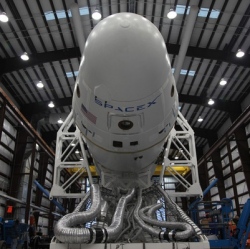
According to Boeing, the company’s schedule calls for a pad abort test in February 2017, followed by an uncrewed flight test in April 2017, then a flight with a Boeing test pilot and a NASA astronaut in July 2017.
SpaceX said they anticipate a pad abort test in about a month, then an in-flight abort test later this year as part of its previous development phase. An uncrewed flight test is planned for late 2016 and a crewed flight test in early 2017.
SpaceX and Boeing have both completed the first milestones in their plans to send humans into space. SpaceX’s goal is to fly over 50 Falcon 9 missions before attempting the first crewed launch in early 2017. Those missions will accommodate four crew members with space for cargo.
Speaking for the first time together since the awarding of the final development and certification contracts, officials from NASA’s Commercial Crew Program, Boeing and SpaceX revealed some of the details of their plans to cross the chasm from spacecraft and launch system design to flight tests, certification and operational missions to the station.
"It’s an incredible testament to American ingenuity and know-how, and an extraordinary validation of the vision we laid out just a few years ago as we prepared for the long-planned retirement of the space shuttle," said Charlie Bolden, NASA administrator, during the briefing at the agency’s Johnson Space Center in Houston. "This work is part of a vital strategy to equip our nation with the technologies for the future and inspire a new generation of explorers to take the next giant leap for America."
Boeing and SpaceX were selected in September 2014 to finalize their respective CST-100 and Crew Dragon spacecraft along with the rockets that will lift them into orbit and all of the ground and mission operations networks essential for safe flights. Both companies have worked with NASA’s Commercial Crew Program throughout multiple development phases, continuing to advance their designs before being chosen to complete their systems, reach certification and then fly astronauts to the station.
